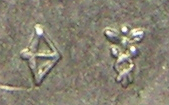Royal Dutch coin
The Royal Dutch Mint (nl. Koninklijke Nederlandse Munt NV ) is the mint of the Netherlands with its seat in Utrecht .
Since 1815 she has used a winged Mercury staff as a mint mark . It has been on all Dutch coins since 1830. The mint building has been located on Leidseweg near the Merwede Canal since 1911 and was designed by CH Peters in a neoclassical style.
history
The first coins in the province of Utrecht were struck in Dorestad in the first half of the 7th century. These were golden tremissis , the former currency in the Roman Empire and the Western Roman Empire . Silver coins for Charlemagne and Ludwig the Pious were later added.
937 the bishop received Balderic of Utrecht by King Otto I the right to mint coins .
1528 the bishop lost this right, which henceforth was the secular rulers and first at Charles V passed. His only son, Philip II , allowed a mint in 1567, which was located on the grounds of the Paulus Abbey. After moving to a new building around 1585, the provinces were allowed to strike coins themselves in 1579. Around 1647 the mint had to move into a new building again, presumably due to a lack of space. The embossing process was also increasingly mechanized in Utrecht.
In 1806 the mint in Utrecht was supposed to be closed due to a new regulation and from 1807 the coins would only be minted centrally. Initially, a mint in Amsterdam was planned. But this did not come about due to lack of money, which is why the mint in Utrecht was the only one of the former provincial coins to be allowed to mint again, as it was best equipped at the time. In 1814 the mint was renamed 's Rijks Munt .
On January 1, 1902, it was directly subordinate to the Ministry of Finance. In 1912 it was converted into a state-owned company. On June 15, 1994, the mint was privatized, but remained 100% state-owned and in autumn 1995 received the addition of "royal".
On November 22, 2016, the Belgian Heylen group took over the mint from the Dutch state for EUR 3.6 million.
Web links
- KNM website (Dutch)
Individual evidence
- ^ Paul Huysmans: Groep Heylen koopt Koninklijke Nederlandse Munt. madeinkempen.be, November 22, 2016, accessed November 24, 2016 (Dutch).
Coordinates: 52 ° 5 ′ 15 " N , 5 ° 5 ′ 44.2" E


